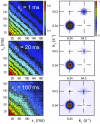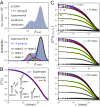Using microsecond single-molecule FRET to determine the assembly pathways of T4 ssDNA binding protein onto model DNA replication forks
- PMID: 28416680
- PMCID: PMC5422767
- DOI: 10.1073/pnas.1619819114
Using microsecond single-molecule FRET to determine the assembly pathways of T4 ssDNA binding protein onto model DNA replication forks
Abstract
DNA replication is a core biological process that occurs in prokaryotic cells at high speeds (∼1 nucleotide residue added per millisecond) and with high fidelity (fewer than one misincorporation event per 107 nucleotide additions). The ssDNA binding protein [gene product 32 (gp32)] of the T4 bacteriophage is a central integrating component of the replication complex that must continuously bind to and unbind from transiently exposed template strands during DNA synthesis. We here report microsecond single-molecule FRET (smFRET) measurements on Cy3/Cy5-labeled primer-template (p/t) DNA constructs in the presence of gp32. These measurements probe the distance between Cy3/Cy5 fluorophores that label the ends of a short (15-nt) segment of ssDNA attached to a model p/t DNA construct and permit us to track the stochastic interconversion between various protein bound and unbound states. The length of the 15-nt ssDNA lattice is sufficient to accommodate up to two cooperatively bound gp32 proteins in either of two positions. We apply a unique multipoint time correlation function analysis to the microsecond-resolved smFRET data obtained to determine and compare the kinetics of various possible reaction pathways for the assembly of cooperatively bound gp32 protein onto ssDNA sequences located at the replication fork. The results of our analysis reveal the presence and translocation mechanisms of short-lived intermediate bound states that are likely to play a critical role in the assembly mechanisms of ssDNA binding proteins at replication forks and other ss duplex junctions.
Keywords: microsecond single-molecule FRET; multidimensional time correlation functions; ssDNA binding protein.
Conflict of interest statement
The authors declare no conflict of interest.
Figures







Similar articles
-
Single-molecule FRET studies of the cooperative and non-cooperative binding kinetics of the bacteriophage T4 single-stranded DNA binding protein (gp32) to ssDNA lattices at replication fork junctions.Nucleic Acids Res. 2016 Dec 15;44(22):10691-10710. doi: 10.1093/nar/gkw863. Epub 2016 Sep 30. Nucleic Acids Res. 2016. PMID: 27694621 Free PMC article.
-
Helicase assembly protein Gp59 of bacteriophage T4: fluorescence anisotropy and sedimentation studies of complexes formed with derivatives of Gp32, the phage ssDNA binding protein.Biochemistry. 2001 Jun 26;40(25):7651-61. doi: 10.1021/bi010116n. Biochemistry. 2001. PMID: 11412119
-
Using Multiorder Time-Correlation Functions (TCFs) To Elucidate Biomolecular Reaction Pathways from Microsecond Single-Molecule Fluorescence Experiments.J Phys Chem B. 2016 Dec 29;120(51):13003-13016. doi: 10.1021/acs.jpcb.6b08449. Epub 2016 Dec 19. J Phys Chem B. 2016. PMID: 27992233 Free PMC article.
-
Biophysical characterization of DNA binding from single molecule force measurements.Phys Life Rev. 2010 Sep;7(3):299-341. doi: 10.1016/j.plrev.2010.06.001. Epub 2010 Jun 4. Phys Life Rev. 2010. PMID: 20576476 Free PMC article. Review.
-
Single-stranded DNA-binding proteins: multiple domains for multiple functions.Structure. 2013 Jul 2;21(7):1074-84. doi: 10.1016/j.str.2013.05.013. Structure. 2013. PMID: 23823326 Free PMC article. Review.
Cited by
-
Studies of DNA 'Breathing' by Polarization-Sweep Single-Molecule Fluorescence Microscopy of Exciton-Coupled (iCy3)2 Dimer-Labeled DNA Fork Constructs.J Phys Chem B. 2023 Dec 21;127(50):10730-10748. doi: 10.1021/acs.jpcb.3c06463. Epub 2023 Dec 7. J Phys Chem B. 2023. PMID: 38060691 Free PMC article.
-
Single-Molecule FRET-Based Dynamic DNA Sensor.ACS Sens. 2021 Mar 26;6(3):1367-1374. doi: 10.1021/acssensors.1c00002. Epub 2021 Mar 15. ACS Sens. 2021. PMID: 33720708 Free PMC article.
-
Single molecule technique unveils the role of electrostatic interactions in ssDNA-gp32 molecular complex stability.RSC Adv. 2024 Feb 13;14(8):5449-5460. doi: 10.1039/d3ra07746b. eCollection 2024 Feb 7. RSC Adv. 2024. PMID: 38352678 Free PMC article.
-
Studies of DNA breathing in exciton-coupled (iCy3)2 dimer-labeled DNA constructs by polarization-sweep single-molecule fluorescence (PS-SMF) microscopy.Proc SPIE Int Soc Opt Eng. 2024 Jan-Feb;12863:128630C. doi: 10.1117/12.3001962. Epub 2024 Mar 13. Proc SPIE Int Soc Opt Eng. 2024. PMID: 39149417 Free PMC article.
-
Temperature-dependent local conformations and conformational distributions of cyanine dimer labeled single-stranded-double-stranded DNA junctions by 2D fluorescence spectroscopy.J Chem Phys. 2022 Jan 28;156(4):045101. doi: 10.1063/5.0076261. J Chem Phys. 2022. PMID: 35105081 Free PMC article.
References
-
- Johnson A, O’Donnell M. Cellular DNA replicases: Components and dynamics at the replication fork. Annu Rev Biochem. 2005;74:283–315. - PubMed
-
- Nossal NG. The bacteriphage T4 DNA replication fork. In: Karam JD, Kreuzer KN, Hall DH, editors. Molecular Biology of Bacteriphage T4. American Society for Microbiology; Washington, DC: 1994. pp. 43–54.
-
- Nossal NG, Makhov AM, Chastain PD, 2nd, Jones CE, Griffith JD. Architecture of the bacteriophage T4 replication complex revealed with nanoscale biopointers. J Biol Chem. 2007;282:1098–1108. - PubMed
-
- Alberts BM. Prokaryotic DNA replication mechanisms. Philos Trans R Soc Lond B Biol Sci. 1987;317:395–420. - PubMed
Publication types
MeSH terms
Substances
Grants and funding
LinkOut - more resources
Full Text Sources
Other Literature Sources
Research Materials

